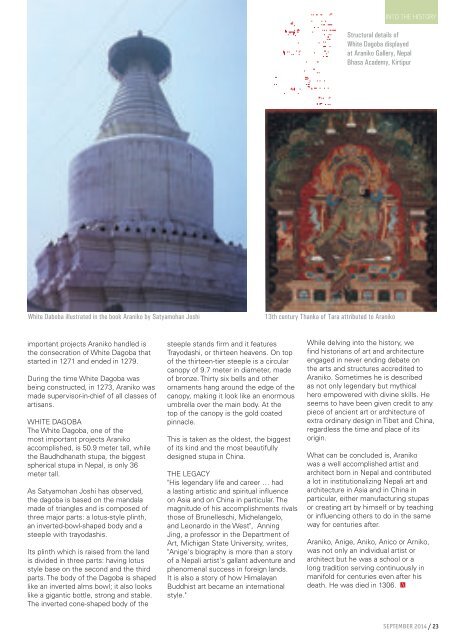9. Sept 2014
You also want an ePaper? Increase the reach of your titles
YUMPU automatically turns print PDFs into web optimized ePapers that Google loves.
INTO THE HISTORY<br />
Structural details of<br />
White Dagoba displayed<br />
at Araniko Gallery, Nepal<br />
Bhasa Academy, Kirtipur<br />
White Daboba illustrated in the book Araniko by Satyamohan Joshi<br />
13th century Thanka of Tara attributed to Araniko<br />
important projects Araniko handled is<br />
the consecration of White Dagoba that<br />
started in 1271 and ended in 127<strong>9.</strong><br />
During the time White Dagoba was<br />
being constructed, in 1273, Araniko was<br />
made supervisor-in-chief of all classes of<br />
artisans.<br />
WHITE DAGOBA<br />
The White Dagoba, one of the<br />
most important projects Araniko<br />
accomplished, is 50.9 meter tall, while<br />
the Baudhdhanath stupa, the biggest<br />
spherical stupa in Nepal, is only 36<br />
meter tall.<br />
As Satyamohan Joshi has observed,<br />
the dagoba is based on the mandala<br />
made of triangles and is composed of<br />
three major parts: a lotus-style plinth,<br />
an inverted-bowl-shaped body and a<br />
steeple with trayodashis.<br />
Its plinth which is raised from the land<br />
is divided in three parts: having lotus<br />
style base on the second and the third<br />
parts. The body of the Dagoba is shaped<br />
like an inverted alms bowl; it also looks<br />
like a gigantic bottle, strong and stable.<br />
The inverted cone-shaped body of the<br />
steeple stands firm and it features<br />
Trayodashi, or thirteen heavens. On top<br />
of the thirteen-tier steeple is a circular<br />
canopy of <strong>9.</strong>7 meter in diameter, made<br />
of bronze. Thirty six bells and other<br />
ornaments hang around the edge of the<br />
canopy, making it look like an enormous<br />
umbrella over the main body. At the<br />
top of the canopy is the gold coated<br />
pinnacle.<br />
This is taken as the oldest, the biggest<br />
of its kind and the most beautifully<br />
designed stupa in China.<br />
THE LEGACY<br />
"His legendary life and career … had<br />
a lasting artistic and spiritual influence<br />
on Asia and on China in particular. The<br />
magnitude of his accomplishments rivals<br />
those of Brunelleschi, Michelangelo,<br />
and Leonardo in the West", Anning<br />
Jing, a professor in the Department of<br />
Art, Michigan State University, writes,<br />
"Anige's biography is more than a story<br />
of a Nepali artist's gallant adventure and<br />
phenomenal success in foreign lands.<br />
It is also a story of how Himalayan<br />
Buddhist art became an international<br />
style."<br />
While delving into the history, we<br />
find historians of art and architecture<br />
engaged in never ending debate on<br />
the arts and structures accredited to<br />
Araniko. Sometimes he is described<br />
as not only legendary but mythical<br />
hero empowered with divine skills. He<br />
seems to have been given credit to any<br />
piece of ancient art or architecture of<br />
extra ordinary design in Tibet and China,<br />
regardless the time and place of its<br />
origin.<br />
What can be concluded is, Araniko<br />
was a well accomplished artist and<br />
architect born in Nepal and contributed<br />
a lot in institutionalizing Nepali art and<br />
architecture in Asia and in China in<br />
particular, either manufacturing stupas<br />
or creating art by himself or by teaching<br />
or influencing others to do in the same<br />
way for centuries after.<br />
Araniko, Anige, Aniko, Anico or Arniko,<br />
was not only an individual artist or<br />
architect but he was a school or a<br />
long tradition serving continuously in<br />
manifold for centuries even after his<br />
death. He was died in 1306.<br />
SEPTEMBER <strong>2014</strong> / 23


















